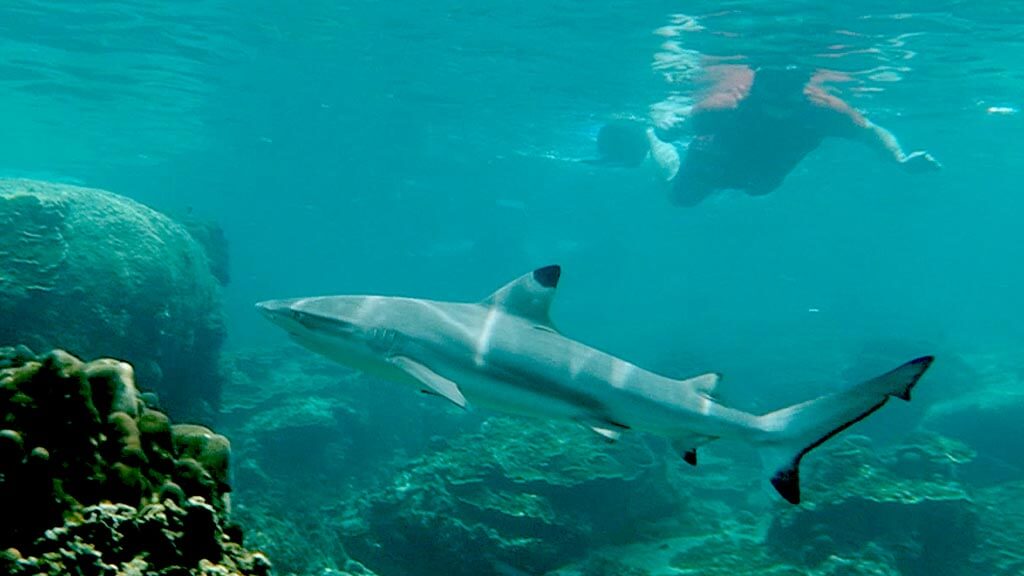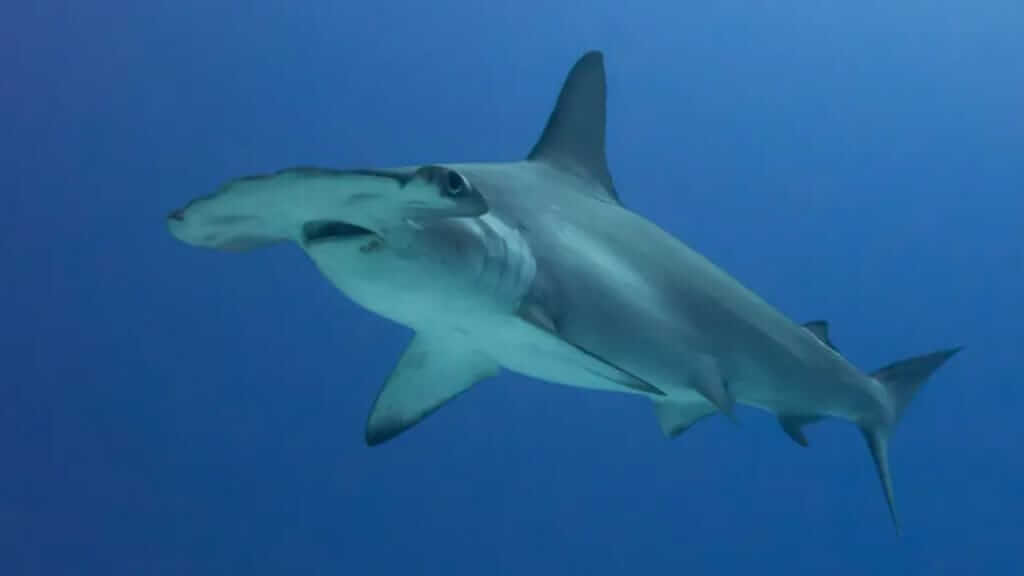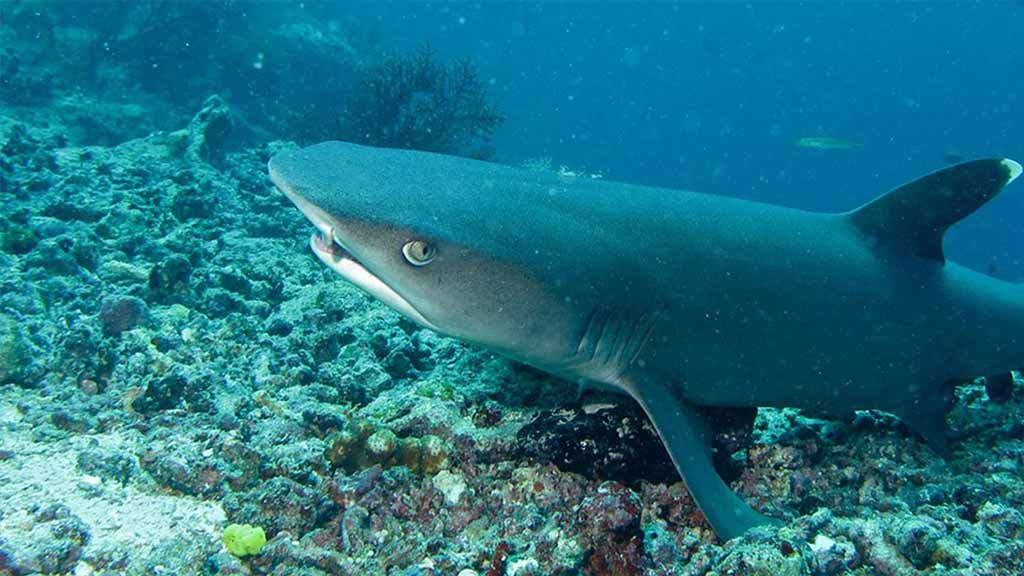Galapagos Sharks
How to See Galapagos Sharks?
An impressive thirty two different shark species have been recorded in Galapagos waters. Here they find protection within the Galapagos Marine Reserve, as well as rich feeding grounds.
The Galapagos islands are a unique place where nutrient-rich cold currents converge with warmer tropical waters. This creates a tropical, temperate and cold-water habitat suitable for a great biodiversity of different marine species. More importantly it creates a perfect hub for many different types of shark species. Some live here all year round, while others are migratory species that pass through during optimal times for feeding.
Even as recently as 2012, a new species of catshark was discovered at Galapagos, indicating that Galapagos waters still hold many secrets.
SECURE YOUR GALAPAGOS TRAVEL
Get a FREE personalised quote todayDiving with Galapagos Sharks:
To find the best diversity and volume of sharks we strongly recommend a Galapagos Scuba Diving tour. This will get you as close as possible to these wonderful creatures, to snap breathtaking underwater photos that will make your friends back home jealous.
Specialist live-aboard dive yachts such as the Aggressor III or Galapagos Sky run cruises to the very best Galapagos dive sites at Darwin and Wolf islands. Here you’ll find the largest shark biomass on the planet – an incredible average of 17.5 shark tons per hectare! These yachts carry all the latest dive equipment on board as well as experienced natuarlist dive guides. Cruises may not be cheap, but they are your only ticket to Darwin and Wolf to see Hammerheads and Whale Sharks.
For a cheaper alternative try Galapagos dive day tours. Visitor dive sites such as Gordon Rocks (Santa Cruz island) or Kicker Rock (San Cristobal island) afford common sightings of white and black tip reef sharks and the Galapagos Shark. Scalloped hammerheads also occasionally cruise through these waters.
Snorkeling with Galapagos islands Sharks:
If you are not a diver then fear not – it is also common to see Galapagos sharks while Snorkelling. Reef sharks love shallow waters around coral, and are often spotted hanging out on the ocean floor. If extremely lucky you might even spot a stray Hammerhead in clear waters.
The best news is that snorkelling is an everyday activity included on Galapagos cruises and Galapagos Land Tours. Some of the top Galapagos snorkeling sites to spot sharks include: Los Tuneles (Isabela island), Darwin Bay (Genovesa island) and North Seymour.
Contact us for a FREE GALAPAGOS TOUR QUOTE, or for advice about which type of tour is your best option to see Galapagos sharks.
Is it safe to dive with Galapagos Sharks?
Since records began (back in the mid 1800’s) there have only been 8 shark-related incidents at the Galapagos Islands. Only 3 of those incidents has ever involved a tourist, and there has never been a single fatality from a Galapagos shark attack.
Naturally a degree of caution is always required when sharing the water with sharks anywhere in the world. We recommend only to snorkel or dive together with an experienced naturalist guide who can recognise if a shark is becoming agitated. It is important always to respect their space, and keep your distance. If a shark does want to be inquisitive around humans then let him come up to you.
So overall yes, the Galapagos islands are considered to be a very safe shark destination.
What types of shark are in Galapagos?
While not a complete list, the Galapagos shark species listed below cover the more common types of sharks in Galapagos. For more detailed information about each shark species just follow the links.
Galapagos Hammerhead Shark
Where to see them? Darwin & Wolf Islands, or occasionally cruising through day dive sites such as Gordon Rocks or Kicker Rock.
When to find them? All year-round, but the best time is from December to April when Galapagos waters are warmest.
Without a doubt the Scalloped Hammerhead Shark is one of the top underwater highlights at the Galapagos Islands! The Scalloped hammerhead is the most common sighting, while Smooth & Great hammerheads might also be spotted occasionally.
Large adult Hammerheads hang out together in schools of several hundred up in the warm waters to the extreme north-west of the archiplego, feeding on abundant schools of fish. Galapagos dive cruises give visitors an excellent opportunity of a positive sighting.
An important Hammerhead shark nursery site has also recently been discovered close to Santa Cruz island. Here baby hammerhead shark pups and juveniles feed among the protected mangroves until big enough to hit the open ocean.
Whitetip Reef Shark
Where to see them? Right across the archipelago, in shallow waters close to coral reefs.
When to find them? Whitetip reef sharks are active all year-round.
The Whitetip Reef Shark is the most common shark species found at the Galapagos islands. They are docile yet inquisitive creatures, and usually easy to tick off of your shark list whilst snorkelling. Los Tintoreras visitor site on Isabela is a great spot to see whitetips from land while they shelter in a shady lave crevasse during the day.
Whitetip reef sharks are easily recognisable by the tell-tale white tips of their first dorsal and upper caudal fins. More often than not they are seen in small groups relaxing on the ocean floor during the day, transforming into deadly hunters at night to feed on reef fish.
Galapagos Shark
Where to see them? Darwin & Wolf Islands, or possibly at day dive sites.
When to find them? All year-round.
The Galapagos shark is one of the largest of the Requiem Shark species, growing up to 3m in length as an adult. They are found around the world, but the largest population is in the Galapagos islands where they were first discovered and named in the 1950s.
The Galapagos Shark mostly hunts bottom-dwelling fish, but are also known to take Fur Seals, Sea Lions and even Marine Iguanas on occasion.
The best way to see a Galapagos Shark is on a dive cruise to Darwin & Wolf islands, but they do also sometimes frequent day dive sites around Santa Cruz, San Cristobal or Isabela islands.
Whale Shark
Where to see them? At Darwin & Wolf islands, especially in the seas around Darwin Arch.
When to find them? Whale shark season at Galapagos is usually best from June to November.
The incredible Whale Shark is the largest species of shark on the planet. The Galapagos Islands are arguably the very best place in the world to dive with these magnificent giants of the deep. To see them you’ll need to take a specialist scuba cruise up to Darwin & Wolf islands where huge adult females pass through on their migratory routes.
Whales sharks prefer the cold water months at Galapagos when rich pickings of plankton are easiest to find. They suck tons of water into their huge mouths to filter out the tiny plankton on mass. Curiously over 90% of Galapagos whale sharks are pregnant females, although it is not really understood why. An important Galapagos Whale Shark Project is currently underway, aiming to understand more about whale shark movements and behavior.
Blacktip Reef Shark
Where to see them? Right across the archipelago.
When to find them? Blacktips are acyive all year-round.
The Blacktip Reef Shark is another common species that can be spotted snorkelling among coral reefs at the isands. These very attractive sharks are recognised by the blacktip painted on all fins, and their sleak, streamlined bodies. It is one of very few shark species capable of jumping completely out of the water – a technique known as breaching.
The Blacktip reef shark (Carcharhinus Melanopterus) is not to be confused with the Blacktip Shark (Carcharhinus Limbatus) which is a considerably larger species.
GET FREE ADVICE
From a Galapagos destination expert todayGalapagos Bullhead Shark
Where to see them? Across the archipelago.
When to find them? All year-round.
The Galapagos Bullhead Shark is something of an enigma. In truth very little is known about their habitat, behavior, or even population size. What we do know is that Galapagos Bullhead sharks are a small-sized, bottom-dwelling species. They have a spotted body, and are thought to date back all the way to the Jurassic Period.
Scientists want to understand more about this elusive Galapagos shark species. An active investigative project is underway supported by the Galapagos Conservation Trust. If you manage to snap an underwater photo of a Galapagos Bull shark, then get in touch with them – your photo and data will be added to the project database to discover more about this forgotten species.
Tiger Shark
Where to see them? At Darwin & Wolf Islands, and sometimes in the Itabaca Channel between Baltra and Santa Cruz islands.
When to find them? Tiger sharks may not be a common sighting at Galapagos but they can be spotted throughout the year. February to June is said to be the best time to see them.
Tiger Sharks surely need no introduction. They are the fourth largest shark species in the world, growing up to an imposing 5 and 1/2 metres, and fierce predators to boot.
They are a migratory shark species that pass through Galapagos waters from time to time. Recent studies by the Charles Darwin Research Station have found that these Apex predators hunt Green Turtles and Sea Lions in Galapagos waters, and help to maintain a healthy ecosystem by controlling the population size of their prey.
Dusky Shark
Where to see them? Darwin & Wolf Islands.
When to find them? All year-round.
The Dusky Shark is another Requiem species. They are often confused in appearance with the Galapagos Shark, it’s distinguishing feature being a slightly larger dorsal fin. Their range is worldwide, especially along coastlines with warm tropical waters. At Galapagos they can be spotted all year-round, but most frequently from January to April when the water temperatures are at their warmest.
Silky Shark
Where to see them? Darwin & Wolf Islands.
When to find them? All year-round.
Silky Sharks are another occasional visitor to the Galapagos Marine Reserve, especially in warmer months from January to April. They can be identified by their smooth, silky skin, and a visible long free tip on the second dorsal fin. They are pelagic, usually found in reefs with deep waters or out in open ocean.
Threats to Galapagos Sharks
Today, the Galapagos Islands are one of the few places in the world where shark numbers are in good health. This is largely thanks to the protective status that they enjoy within the Galapagos Marine Reserve.
However, that is not to say that Galapagos shark populations are as rosy as they should be. The Whale Shark is an endangered species. The Scalloped Hammerhead is critically endangered. So little is know about that the poor Galapagos Bullhead Shark that it’s protected status is not even known.
The Chinese market for illegal shark fins puts many species at risk. While sharks are protected within the marine reserve, most are migratory species that can easily be caught as soon as they leave protected waters.
Ecuadorian protective laws have certainly helped the situation. In 1998 the Special Law for Galapagos was passed, creating the 133,000 sq. km Galapagos Marine Reserve (GMR), and outlawing commercial fishing including shark finning and long-lining. We saw further progress in 2004, with a ban on the export of any shark products, putting Ecuador at the forefront of global shark conservation. However, part of this progress was lost in 2007 with the announcement that shark fins from incidental catches can be exported. So plenty of work still needs to be done here.
A clear example of the continued threat from illegal fishing was made apparent in August 2017, when a Chinese fishing vessel was stopped inside Galapagos Marine Reserve waters carrying thousands of captured sharks. The 20 crew were given prison sentances, and a $5.9M fine to pay, but the biological damage was irreversible. More recently in 2020 a huge chinese fishing fleet parked themselves for several weeks right on the border of the Galapagos marine reserve, which whilst legal is highly questionable in terms of ethics. These behaviors cast a shadow on shark conservation efforts at the Galapagos islands.
These are just a couple of examples of the challenges faced today to protect Galapagos sharks and other marine species. The GMR covers a huge area of open ocean, making it difficult to effectively police. Illegal fishing in and around Galapagos waters is known to be common occurence, but more resources are needed to enforce protective regulations and continue to protect shark population numbers at Galapagos.
The #1 Trusted
Galapagos Travel Agency
If you enjoyed this blog, then we think you’ll also like our posts about: Galapagos Birds, Galapagos Animals, and Whale species that visit Galapagos.
In conclusion, there are many fascinating species of Galapagos sharks for visitors to discover. Not only do the Galapagos islands boast the highest shark biomass on the planet, but it’s also a safe place to share the water with them. Galapagos tours include great opportunities to get up close to marine species, including sharks. So get your fins and snorkel at the ready, and dive right in!

















